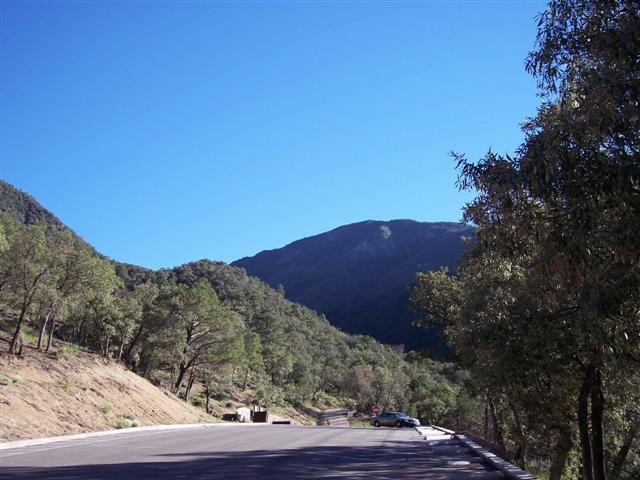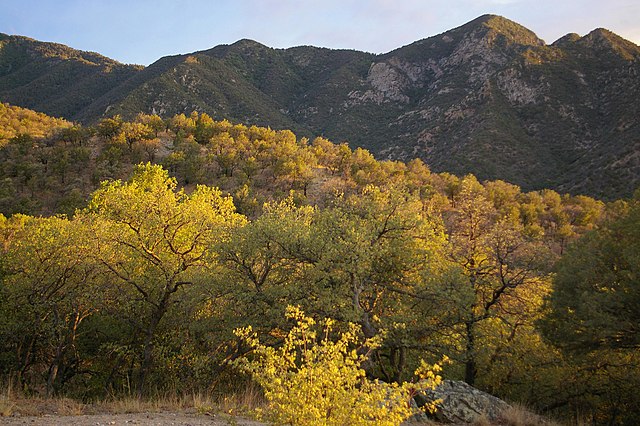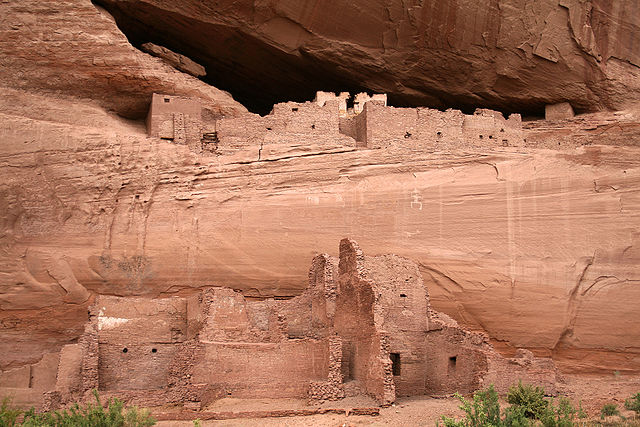Nestled in the heart of Arizona’s Santa Rita Mountains, Madera Canyon stands as one of the Southwest’s most spectacular natural treasures. This hidden gem offers an extraordinary escape from the desert heat, where towering sycamores and oaks create a lush oasis that attracts wildlife enthusiasts from around the globe. But what makes this canyon so special that seasoned birders consider it a pilgrimage destination?
What Makes Madera Canyon Special?
Madera Canyon isn’t just another pretty spot in Arizona – it’s a biological wonderland that defies expectations. Picture this: you’re driving through typical Sonoran Desert landscape, complete with saguaro cacti and prickly pear, when suddenly you’re transported into what feels like a completely different world. The canyon creates its own microclimate, supporting an incredible diversity of plant and animal life that you simply won’t find anywhere else in the region.
Geographic Location and Setting
Located approximately 40 miles southeast of Tucson, Madera Canyon sits at the base of Mount Wrightson, the highest peak in the Santa Rita Mountains. The canyon stretches roughly 15 miles into the mountains, with elevations ranging from 2,800 feet at the entrance to over 9,000 feet at the summit. This dramatic elevation change creates distinct ecological zones, each supporting different species of plants and animals.
The canyon’s name comes from the Spanish word “madera,” meaning wood or timber, which perfectly describes the forested environment that greets visitors. Unlike the surrounding desert, Madera Canyon features riparian woodlands filled with Arizona sycamores, Fremont cottonwoods, and various oak species that create a canopy of green throughout much of the year.
Unique Ecosystem and Climate
What sets Madera Canyon apart is its remarkable ecosystem diversity. The canyon acts as a natural corridor, allowing species typically found in Mexico’s mountains to extend their range northward. This creates what biologists call a “sky island” effect – an isolated mountain habitat surrounded by dramatically different lowland environments.
The climate here is significantly cooler and more humid than the surrounding desert. Summer temperatures rarely exceed 85°F in the canyon, while the desert floor might be pushing 110°F. This temperature difference makes Madera Canyon a year-round destination, offering refuge from Arizona’s extreme summer heat and providing comfortable conditions for outdoor activities.
Getting to Madera Canyon

Planning your journey to Madera Canyon requires some preparation, but the drive itself becomes part of the adventure. The route takes you through diverse landscapes that showcase Arizona’s natural beauty.
Driving Directions from Tucson
From Tucson, take Interstate 19 south toward Nogales for about 25 miles. Take Exit 63 for Continental Road and head east. After approximately 13 miles, you’ll reach the Madera Canyon turnoff. The final 13 miles to the canyon are on a winding mountain road that climbs steadily through changing vegetation zones.
The drive typically takes about an hour from Tucson, but you’ll want to allow extra time for stops along the way. The road is paved and well-maintained, suitable for most vehicles, though you’ll encounter some steep grades and sharp curves. RVs longer than 40 feet or those towing large trailers should use caution or consider alternative transportation.
Transportation Options
While having your own vehicle provides the most flexibility, several tour companies offer guided trips to Madera Canyon. These tours often include transportation, expert guides, and specialized equipment for birdwatching or photography. For serious birders, guided tours can be invaluable for spotting rare species and learning about the canyon’s unique ecosystem.
If you’re staying in Tucson without a car, consider renting one specifically for your Madera Canyon adventure. The freedom to explore at your own pace and return for different lighting conditions or wildlife activity periods makes having a vehicle worthwhile.
Best Time to Visit Madera Canyon
Timing your visit to Madera Canyon can make the difference between a good experience and an absolutely magical one. The canyon offers something special throughout the year, but certain seasons provide optimal conditions for specific activities.
Seasonal Weather Patterns
Spring (March through May) brings mild temperatures and wildflower blooms that transform the canyon into a colorful paradise. Daytime temperatures range from 60-75°F, perfect for hiking and extended outdoor activities. This season also marks the beginning of migration periods, when various bird species pass through the canyon.
Summer (June through August) offers the coolest refuge from Arizona’s brutal heat. While temperatures in Tucson soar above 100°F, the canyon maintains comfortable conditions in the 70s and 80s. However, this is also monsoon season, with afternoon thunderstorms common from July through September.
Fall (September through November) provides some of the most pleasant weather conditions, with clear skies and comfortable temperatures. The changing leaves create spectacular photography opportunities, and many resident bird species are most active during this period.
Winter (December through February) brings cooler temperatures but remains mild compared to northern climates. Daytime temperatures typically range from 45-65°F, and while some higher elevation areas might experience frost, the main canyon areas remain accessible and enjoyable.
Peak Birding Seasons
For birdwatchers, the optimal times are during migration periods – late April through early June and August through October. During these periods, you might spot over 100 bird species in a single day. The famous hummingbird activity peaks from March through October, with the greatest diversity occurring from July through September when multiple species overlap.
Top Activities in Madera Canyon

Madera Canyon offers activities for every type of nature enthusiast, from casual visitors seeking a peaceful retreat to serious researchers conducting scientific studies. The canyon’s diverse ecosystem supports an incredible range of experiences.
Birdwatching Opportunities
Madera Canyon ranks among North America’s premier birding destinations, with over 240 recorded species. The canyon’s unique position as a meeting point between different biogeographic regions creates opportunities to see species that rarely occur together elsewhere.
Hummingbird Species
The canyon’s claim to fame lies in its extraordinary hummingbird diversity. Fifteen different hummingbird species have been recorded here, including several that are rare or absent elsewhere in the United States. The Broad-billed Hummingbird, with its brilliant blue and green plumage, is practically guaranteed during warmer months. You might also spot the tiny Calliope Hummingbird, North America’s smallest bird, or the spectacular Blue-throated Mountain-gem.
The best hummingbird viewing occurs at the various feeding stations maintained by local lodges and the visitor center. Early morning and late afternoon provide the most activity, when these tiny birds are most actively feeding. Bring a good pair of binoculars – hummingbirds move quickly, and the details of their iridescent plumage are worth seeing up close.
Rare Bird Sightings
Beyond hummingbirds, Madera Canyon offers opportunities to see birds that are extremely rare in the United States. The Elegant Trogon, a spectacular tropical species, nests in the canyon during summer months. This bird, with its brilliant red breast and green back, represents the northernmost extent of its range.
Other specialty species include the Sulphur-bellied Flycatcher, Arizona Woodpecker, and various vireo species. During migration periods, unexpected rarities can appear, making every visit potentially historic for serious birders.
Hiking Trails and Nature Walks
The canyon offers trails for every fitness level and interest. Whether you’re looking for a gentle stroll through riparian woodlands or a challenging climb to mountain peaks, you’ll find options that suit your abilities.
Easy Family-Friendly Trails
The Nature Trail near the visitor center provides an excellent introduction to the canyon’s ecosystem. This gentle, 1-mile loop trail features interpretive signs explaining the area’s plants, animals, and geological features. The trail is suitable for children and those with limited mobility, offering paved sections and minimal elevation gain.
The Proctor Road Trail follows an old mining road through beautiful oak woodlands. This 2-mile round trip hike offers excellent wildlife viewing opportunities without requiring significant physical exertion. The trail provides multiple spots for rest and photography, making it perfect for families with children.
Challenging Mountain Hikes
For experienced hikers, the Mount Wrightson Trail offers a serious challenge with spectacular rewards. This 11-mile round trip hike climbs nearly 4,000 feet to reach the highest peak in the Santa Rita Mountains. The trail passes through multiple ecological zones, from oak woodlands to pine forests to alpine meadows.
The Vault Mine Trail provides a moderate challenge with historical interest. This 4-mile round trip hike leads to the ruins of an old mining operation while offering excellent views of the canyon and surrounding mountains. The trail requires some scrambling over rocks but doesn’t demand extreme fitness levels.
Photography Adventures
Madera Canyon provides endless opportunities for photographers, from intimate macro shots of wildflowers to sweeping landscape vistas. The canyon’s diverse lighting conditions, created by its narrow walls and changing elevations, offer dramatic possibilities throughout the day.
Wildlife photography here is exceptional, with opportunities to photograph everything from tiny hummingbirds to large mammals like coatis and deer. The key to successful wildlife photography in the canyon is patience and understanding animal behavior patterns.
Where to Stay Near Madera Canyon

Accommodation options near Madera Canyon range from primitive camping to comfortable lodges, each offering different advantages for exploring the area.
Camping Options
Bog Springs Campground, located within the canyon, provides the most immersive experience. This small campground offers 13 sites nestled among oak trees, with restrooms and picnic tables but no showers or hookups. The campground operates on a first-come, first-served basis, so arrive early during peak seasons.
For RV camping, Patagonia Lake State Park, located about 30 minutes away, provides full hookups and amenities. While not as close to the canyon, this option offers more facilities and space for larger rigs.
Nearby Lodging
Several lodges within the canyon cater specifically to nature enthusiasts. The Santa Rita Lodge offers comfortable accommodations with hummingbird feeders right outside your door. The lodge provides breakfast and maintains extensive feeding stations that attract dozens of bird species.
Madera Kubo offers a unique glamping experience with comfortable cabins that blend into the natural environment. These accommodations provide modern amenities while maintaining a close connection to nature.
For traditional hotel accommodations, Tucson offers numerous options about an hour’s drive away. This choice provides access to restaurants, shopping, and other amenities while allowing day trips to the canyon.
Essential Packing List
Proper preparation ensures you’ll make the most of your Madera Canyon adventure. The canyon’s unique environment requires specific equipment and supplies.
Birding Equipment
Quality binoculars are essential for any Madera Canyon visit. Choose models with at least 8x magnification – 8×42 or 10×42 are popular choices that provide good magnification while remaining comfortable for extended use. A spotting scope can be valuable for distant or tiny birds, though it’s not necessary for most visitors.
Field guides specific to Arizona birds will help you identify the species you encounter. Consider bringing a notebook to record your sightings – many visitors find that keeping a list enhances their experience and helps them remember specific encounters.
Hiking Gear
Comfortable, sturdy hiking boots are crucial for navigating the canyon’s rocky terrain. Even easy trails can be uneven, and proper footwear prevents injuries and increases comfort. Bring layers of clothing, as temperatures can vary significantly with elevation and time of day.
A good daypack allows you to carry water, snacks, and equipment comfortably. Include a first aid kit, flashlight, and emergency whistle for safety. Don’t forget sun protection – even in the shaded canyon, UV exposure can be significant at higher elevations.
Wildlife Safety Tips
Madera Canyon is home to various wildlife species, and understanding how to interact safely with them enhances your experience while protecting both you and the animals.
Mountain lions, though rarely seen, inhabit the canyon. Make noise while hiking, especially in dense vegetation or around blind corners. If you encounter a mountain lion, maintain eye contact, appear large, and back away slowly. Never run or turn your back on the animal.
Rattlesnakes are present but generally avoid human contact. Watch where you step and sit, especially in rocky areas or near water sources. Most snake encounters result from accidentally surprising the animal – making noise while hiking usually prevents these situations.
Javelinas, pig-like animals native to the region, can be aggressive if they feel threatened or are protecting young. Give them plenty of space and never attempt to feed them. If you encounter javelinas, speak calmly and back away slowly.
Local Dining and Amenities
While Madera Canyon itself offers limited dining options, nearby communities provide excellent opportunities to experience local cuisine and culture.
The nearby town of Tubac offers several restaurants featuring Southwestern cuisine and local specialties. Many establishments emphasize locally sourced ingredients and traditional preparation methods that reflect the area’s cultural heritage.
Continental, the closest community to the canyon, provides basic services including a small market for supplies and snacks. For more extensive shopping and dining options, Tucson offers everything from casual cafes to fine dining establishments.
Planning Your Madera Canyon Adventure
Successful Madera Canyon visits require some advance planning, especially during peak seasons. The canyon’s popularity among birders and hikers means that accommodation and camping sites fill quickly during optimal viewing periods.
Make reservations well in advance if you plan to stay in canyon lodges or nearby accommodations. Consider booking multiple nights to allow for different activities and weather conditions. A longer stay also increases your chances of seeing rare or elusive wildlife species.
Check current conditions before your visit, as weather can affect trail accessibility and wildlife activity. The canyon’s elevation means that conditions can change rapidly, and preparation helps ensure a safe and enjoyable experience.
Consider joining local birding groups or guided tours, especially if you’re new to the area. Local experts can provide valuable insights into current wildlife activity and help you locate specific species you’re hoping to see.
Conclusion
Madera Canyon represents one of Arizona’s most remarkable natural treasures, offering experiences that surprise and delight visitors from around the world. Whether you’re drawn by the incredible birding opportunities, the challenging hiking trails, or simply the chance to escape into a cool, green oasis, this canyon provides memories that last a lifetime.
The canyon’s unique ecosystem creates a meeting place between different biological worlds, resulting in wildlife diversity that few locations can match. From the tiniest hummingbirds to the largest mammals, from delicate wildflowers to towering sycamores, every aspect of Madera Canyon tells a story of adaptation and survival in one of nature’s most remarkable settings.
Your adventure in Madera Canyon will likely leave you planning your return visit before you’ve even left. The canyon’s changing seasons, migrating wildlife, and endless discovery opportunities mean that each visit offers something new and exciting. Pack your binoculars, lace up your hiking boots, and prepare for an unforgettable journey into one of the Southwest’s most magical destinations.
Frequently Asked Questions
Q: What’s the best time of year to see hummingbirds in Madera Canyon?
A: Hummingbird activity peaks from March through October, with the greatest diversity occurring from July through September. During peak season, you might see 8-10 different species in a single day, including several that are rare elsewhere in the United States.
Q: Are the hiking trails in Madera Canyon suitable for beginners?
A: Yes, the canyon offers trails for all skill levels. The Nature Trail and Proctor Road Trail are perfect for beginners and families, while more challenging options like Mount Wrightson Trail cater to experienced hikers seeking adventure.
Q: Can I camp in Madera Canyon year-round?
A: Bog Springs Campground operates year-round, though winter nights can be quite cold at the canyon’s elevation. The campground fills quickly during peak birding seasons, so arrive early or have backup accommodation plans.
Q: What should I bring for a day trip to Madera Canyon?
A: Essential items include binoculars, comfortable hiking shoes, layers of clothing, water, snacks, sun protection, and a camera. A field guide to Arizona birds will enhance your wildlife viewing experience significantly.
Q: How far is Madera Canyon from major Arizona cities?
A: The canyon is approximately 40 miles southeast of Tucson (about 1 hour drive) and roughly 65 miles from Phoenix (about 1.5 hours). The drive from Tucson takes you through beautiful desert landscapes before ascending into the mountain environment.

